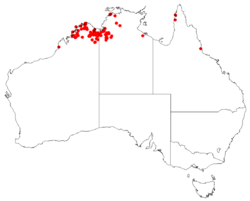Biology:Acacia dunnii
| Elephant ear wattle | |
|---|---|

| |
| Scientific classification | |
| Kingdom: | Plantae |
| Clade: | Tracheophytes |
| Clade: | Angiosperms |
| Clade: | Eudicots |
| Clade: | Rosids |
| Order: | Fabales |
| Family: | Fabaceae |
| Subfamily: | Caesalpinioideae |
| Clade: | Mimosoid clade |
| Genus: | Acacia |
| Species: | A. dunnii
|
| Binomial name | |
| Acacia dunnii | |

| |
| Occurrence data from AVH | |
| Synonyms[1] | |
|
Acacia sericata var. dunnii Maiden | |
Acacia dunnii, commonly known as elephant ear wattle[3] or Dunn's wattle,[4] is a shrub or tree of the genus Acacia and the subgenus Plurinerves.
Names
Its specific epithet, dunnii, is to honour Edward Dunn, government geologist for Victoria (1904–1912).[5] Aboriginal names for it are: (in) Jaminjung, Ngaliwurru, Nungali: Bawaya (Jam, Ngal); (in) Ngarinyman: Barrawi.[3]
Description
This small shrub or tree flowers and fruits in all months of the year.[3] The erect, slender shrub or tree typically grows to a height of 1.5 to 6 metres (5 to 20 ft)[6] and a width of 2 to 4 metres (7 to 13 ft).[7] It blooms from January to June and produces yellow flowers.[6] A. dunnii generally has only a single stem. The silvery blue phyllodes are 20 to 45 centimetres (8 to 18 in) long and 6 to 16 cm (2 to 6 in) wide and hang vertically from branches.[7] It has terminal inflorescences with an axis that is 21 to 27 cm (8 to 11 in) long. The yellow flower Heads are globular with a diameter of 8 to 15 millimetres (0.3 to 0.6 in).[3] After flowering brown woody seed pods form. The pods have a flat linear to oblong shape and can be slightly curved with a length of 6 to 14.5 cm (2 to 6 in) and a width of 2.4 to 3 cm (0.9 to 1.2 in).[3]
Taxonomy
The species was formally described by the botanist William Bertram Turrill in 1922 in the work Dunn's Wattle as published in the Bulletin of Miscellaneous Information. Synonyms for the plant include Racosperma dunnii as described by Leslie Pedley and Acacia sericata var. dunnii by Joseph Maiden.[4]
Distribution
It is native to an area in the Northern Territory and the Kimberley region of Western Australia.[6] Despite records for Queensland,[8] the Commonwealth Heads of Australian Herbaria consider A dunnii not to be native to Queensland, but to have become naturalised.[9] It grows on shallow skeletal sandy soils, over sandstone or quartzite[3][5] Often found on ridges, stony hills and amongst rocks and rocky outcrops.[6]
See also
References
- ↑ 1.0 1.1 Govaerts, R. et al. 2018. "Plants of the World online: Acacia dunnii". Board of Trustees of the Royal Botanic Gardens, Kew. https://powo.science.kew.org/taxon/urn:lsid:ipni.org:names:470221-1. Retrieved 29 May 2018.
- ↑ Turrill, W.B. 1922. Dunn's Wattle. Bulletin of Miscellaneous Information, Royal Gardens, Kew (9) 299
- ↑ 3.0 3.1 3.2 3.3 3.4 3.5 "NT Flora Northern Territory flora online factsheet: Acacia dunnii (Maiden) Turrill". http://eflora.nt.gov.au/factsheetaspdf?id=3440&floraid=2049&logo=. Retrieved 31 May 2018.
- ↑ 4.0 4.1 "Acacia dunnii Turrill". Global Biodiversity Information Facility. https://bie.ala.org.au/species/http://id.biodiversity.org.au/node/apni/2893621#names. Retrieved 21 August 2018.
- ↑ 5.0 5.1 Moore, P. 2005. A guide to plants of Inland Australia, Reed New Holland, Sydney, Australia ISBN:9781876334864
- ↑ 6.0 6.1 6.2 6.3 "Acacia dunnii". FloraBase. Western Australian Government Department of Parks and Wildlife. https://florabase.dpaw.wa.gov.au/browse/profile/3313.
- ↑ 7.0 7.1 "Elephant Ear Wattle Acacia dunnii". Native plant notes. Kings Park and Botanic Gardens. https://www.bgpa.wa.gov.au/images/horticulture/docs/pn_acacia_dunnii.pdf. Retrieved 21 August 2018.
- ↑ "AVH mapview: Acacia dunnii". Australasian Virtual Herbarium. http://avh.ala.org.au/occurrences/search?taxa=Acacia+dunnii#tab_mapView. Retrieved 29 May 2018.
- ↑ "APNI: Acacia dunnii". Australian Plant Name Index. https://biodiversity.org.au/nsl/services/search?product=APC&tree.id=1133571&name=Acacia+dunnii+Turrill&inc._scientific=&inc.scientific=on&inc._cultivar=&max=100&display=apc&search=true. Retrieved 29 May 2018.
External links
Wikidata ☰ {{{from}}} entry
 |


